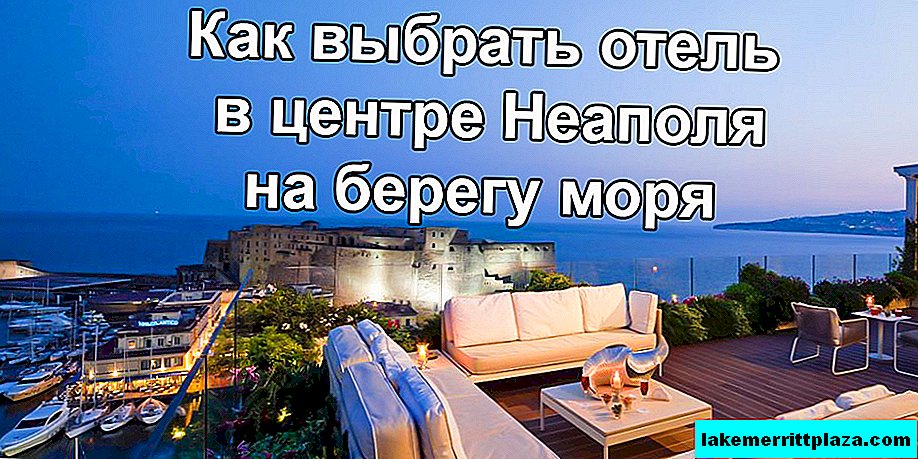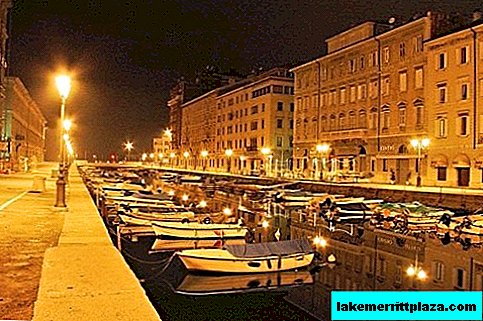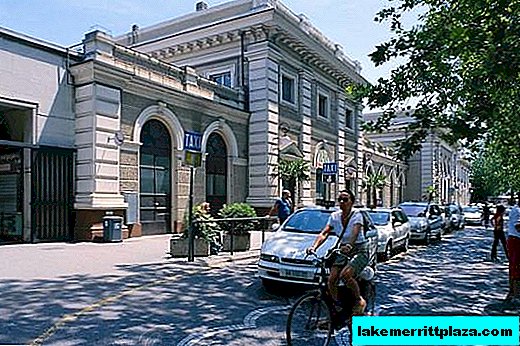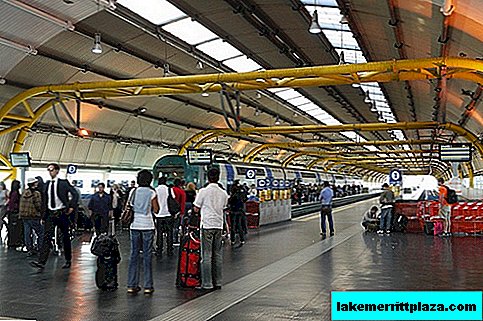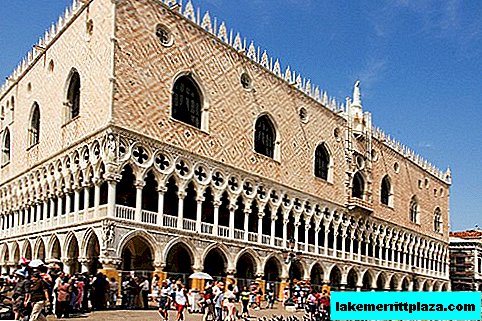The second number of the program for exploring the ancient cities of Germany, which our hospitable friends organized for us, was a trip to Koblenz. Koblenz is located on both banks of the Rhine and has a very ancient and glorious history.

Ehrenbreitstein Fortress
German sketches. Part I
German sketches. Part II
German sketches. Part III
German sketches. Part iv
German sketches. Part v
German sketches. Part VI
German sketches
Part VII. Ehrenbreitstein Fortress
The second number of the program of acquaintance with the ancient cities of Germany, which our hospitable friends Tatyana and Erich organized for us, was a trip to Koblenz.
From the town of Kreuztal, where we lived, to Koblenz the distance is about the same as to Cologne - about seventy kilometers. Like Cologne, Koblenz is located on both banks of the Rhine and, like Cologne, has a very ancient and glorious history. True, in comparison with the millionth Cologne, Koblenz is a small city and lives in it a little more than one hundred thousand inhabitants. Most of the city is located on the left, west bank of the Rhine. In this part of the city are the most interesting neighborhoods for exploring with houses of ancient architecture, ancient Romanesque and Gothic churches, the Elector's Palace and other attractions.
We entered the city from the east, where on the right high bank of the Rhine stands the powerful Ehrenbreitstein fortress, one of the three largest preserved fortresses in Western Europe.
By the way, throughout almost all of its general history, the Kohlenz and Ehrenbreitstein, separated by the Rhine, were separate settlements that were not related to each other. Also, for example, as the cities of Buda and Pest divided by the Danube in Hungary. It was only in 1937 that Ehrenbreitstein was administratively subordinated to Koblenz and became one of its housing estates.
Erenbreitstay was founded around the year 1000, that is, almost a thousand years later than Koblenz, and, like most of the fortifications on the banks of the Rhine, initially served as a customs post. Over time, the castle turned into a large powerful fortress, which was never taken by storm in its entire history. True, twice her garrisons capitulated before the enemy, unable to bear the burdens of the siege.
Unfortunately, now it is impossible to see the fortress in its original, medieval form. In 1801, after the end of the next revolutionary war, the army of revolutionary France, leaving the right bank of the Rhine, blew up the fortress, leaving a pile of ruins from it. Remember how A.N. Ostrovsky: "So do not get to anyone!" It painfully did not want the French during the next war to again spend time and energy on the siege of Ehrenbreitstein.
Fourteen years later, the anti-Napoleonic coalition finally pinched the tail of the restless Buonaparte and enthusiastically began to redraw the land in Europe. Prussia, among other things, went to the Rhine region, including Koblenz and Ehrenbreitstein. Since the Prussians were very serious and solid people, they immediately set about building a new fortress in Ehrenbreitstein. Construction continued from 1817 to 1832. The fortress turned out to be wonderful, however, subsequently it was never used for its intended purpose for two reasons. Firstly, in the second half of the 19th century, Germany was united and strengthened so much that its neighbors, even in their thoughts, did not plan to attack it. Secondly, less than a hundred years have passed, and the nature of wars under the influence of many factors has changed so much that the fortresses lost their former significance as defensive objects.
Fortunately, for quite some time only tourists have stormed them. Yes, and I myself, as a sinful thing, like to occasionally do this. Over the past few years, my wife and I were fortunate enough to visit the Alanya fortress in Turkey, the former royal castle of Karlstejn in the Czech Republic and the stronghold of the Knights Ioannites in Greek Rhodes, amazing in its size and power. And here is Ehrenbreitstein.
We started our tour of the fortress from the funicular station connecting the two banks of the Rhine (the funicular was launched just recently - in 2010).

Right-bank funicular station

Cable Car
The funicular was not yet working, a team of repairmen was preparing it for commissioning after a winter stop.
During the working period, you can buy a comprehensive ticket for 12 euros at the lower left-bank funicular station, including a round-trip cable car ride to the fortress and the entrance to the fortress. A separate fare costs 8 euros, a separate entrance to the fortress is 6 euros. You can see the fortress from 10-00 to 17-00 (November-March) and from 10-00 to 18-00 (April-October).
A shield with a fortress scheme is installed near the station. Tourists who arrived by cable car from the left bank can immediately familiarize themselves with this scheme.

The billboard with the scheme of the fortress
Not far from the billboard with the scheme there is still a stand with a model of the fortress.

Fortress layout
From here, the outer bastions are already visible.

The outer bastion of the fortress
We buy tickets at the box office and through the turnstile we enter the territory of the fortress. By the way, small brochures are issued along with tickets.
And here is the main gate of the fortress.

Main gate
They are located on the east side, since from the west, from the Rhine, the approach to the fortress is practically impossible - it stands on a 118-meter steep cliff.

One of the western bastions of the fortress
From the east, the fortress is more vulnerable, therefore it is more thoroughly fortified from this side. Through the main, outer gate, the path leads to another gate - the inner one.

Inner gate
Through the internal gate we get into the main moat. This moat has nothing to do with the moats of medieval fortresses. It does not surround the fortress around the perimeter, is not filled with water, there are no pointed stakes and slingshots at the bottom of it. In Ehrenbreitstein, the main castle moat is an elongated space, bounded on the outside and inside by the walls of the fortress bastions.

Fragment of the main castle moat
The enemy, breaking into the moat through the gate, in the open space had no opportunity to hide from the fire of the defenders, which was conducted through the embrasures of the bastions, and was doomed to destruction.
There is one very attractive place for tourists in the moat. I suspect that a little less than one hundred percent of visitors to the fortress are photographed in this guardhouse.

Watchtower in the main moat
To make it easier for tourists to feel the atmosphere of that era, military music sounds quietly from the speakers hidden in the walls of the fortress. Yes, the very flutes and drums under which the European infantry marched on the parade ground in the eighteenth and nineteenth centuries, learning the cohesion of actions and the precise execution of the commands of their commanders.
Now in the fortress of Ehrenbreitstein is the local history museum of Koblenz. From the castle moat, we went up to the premises where museum expositions are located.
Among the samples of fortress artillery in the museum there is also an ancient Roman ballista, as a reminder that the legions of Gaius Julius Caesar came to these places even before the beginning of our era.

Ancient Roman Ballista

Fortress gun

Fortress gun
And this is a proud Prussian eagle.

Coat of arms of the Kingdom of Prussia
Most of the museum exhibits relate to military subjects.

The exhibit of the fortress museum

This shot the enemy

And with this he was stabbed and chopped
In their free time, the garrison troops were not averse to smoking a pipe and drinking a glass of beer.

Garrison household items
Having examined most of the halls of the museum, we went up to the highest level in this part of the fortress and found a space here, which is difficult to find a name for. It is a kind of landscape zone with a creative mix of garden and park style. A sort of garden square or, if you like, a bad garden.

Square on the walls

Lawn or garden bed?
The mind realizes that the cabbage is decorative, but the stereotypes are automatically turned on: "If the cabbage - then the garden."

But who needs fresh vitamins?

March flowers
Pretty unexpected and funny. After admiring the flowers and cabbage, we go further.
Wandering through serf mazes and passages is more than fascinating.

Ehrenbreitstein Fortress

Ehrenbreitstein Fortress

Ehrenbreitstein Fortress

Ehrenbreitstein Fortress

Ehrenbreitstein Fortress

Ehrenbreitstein Fortress
The photo shows that the fortress architecture of the XIX century was unpretentious-minimalistic - right angles prevail everywhere. But from this, the inspection of the fortress is not made less interesting.
Finally, we go to the place where the high wall divides the fortress in half, separating its eastern part from the western. At the foot of the wall is a moat; there is a gate for the passage.

Entrance to the western part of the fortress
Obviously, according to the plan of the military engineers who designed the fortress, if it was impossible to keep the eastern part of the fortress, which was more vulnerable to storming, the garrison could retreat to the western part and, hiding behind its high wall, continue the defense.
The next photo shows the back of the wall separating the fortress - it has several tiers with loopholes and embrasures for firing at the eastern part of the fortress captured by the enemy.

Fortress Wall in Ehrenbreitstein
Immediately behind the wall is a vast area framed by several buildings. On the opposite side of the gate of the square is the same 118-meter cliff, on which the Ehrenbreitstein fortress stands. At the edge of the cliff there is a viewing platform with a magnificent panorama of the city of Koblenz.

At the observation deck

At the observation deck
It is from here that the best-known German corner is best seen - the river arrow at the confluence of the Rhine and the Moselle (I will tell you more about German coal in the next part of the report).

Deutsches Eck - German Corner
The view of the German corner from Ehrenbreitstein is captured from different angles in many photographs and is one of the most recognizable views of Germany.
The next photo shows the left-bank funicular station and, slightly to the right of it, the Roman Basilica of St. Castor, known for having held preliminary negotiations on the division of the Frankish Empire of Charlemagne.

Koblenz in the morning haze
Down the Rhine, river ships sail past the fortress.

River vessels on the Rhine
At the foot of the cliff on which the fortress stands, railways are laid along the banks of the Rhine.

Railway at the foot of the ramparts
You can walk around Ehrenbreitstein for at least an entire day. All conditions for a comfortable stay on the territory of the fortress are available.

Modern plumbing in the interior of the XIX century
To the right of the observation deck is a building that houses a cafe and a restaurant.

Fort Tavern
To the left of the observation deck is a large complex of a youth center, which includes the hostel. So those who wish can spend the night right on the territory of the fortress.
Our tour was completed, and we headed to the exit. On the way, we saw this memorial in honor of the soldiers who died in all the wars waged by Germany.

War memorial
At the end of the excursion (or before its beginning), you can buy a souvenir medal in the machine in memory of the Ehrenbreitstein fortress.

Souvenir vending machine
Leaving the fortress, we headed to the left bank of the Rhine to walk around the historic center of Koblenz. Driving through the residential neighborhoods of Ehrenbreitstein and looking at the fortress from the side, we found that in a short distance from the fortress there are several separately standing towers. Since their appearance was completely inconsistent with the style in which the new Prussian fortress was built, I venture to suggest that these towers are surviving fragments of the medieval fortifications of Ehrenbreitstein. It is known that underground passages with a total length of about 4.5 kilometers permeate the thickness of the fortress mountain. Therefore, it is likely that freestanding towers are connected by underground passages to the main complex of the fortress. However, this is only speculation.
And this is what the fortress looks like when viewed from the left bank of the Rhine.

View of the Ehrenbreitstein fortress from the left bank of the Rhine
We took this picture while walking along the embankments of the Rhine and the Moselle in the historic center of Koblenz. I will tell you about the walk in the next part of the report.
German sketches. Part VIII
German sketches. Part IX
German sketches. Part x




